The Teutons, a Germanic People - Who Were They?1
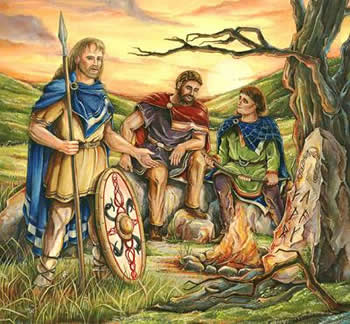
The Teutons
The Teutons included a number of people with similar languages, cultures and lifestyles who lived in Northern Europe and Central Europe (Scandinavia, Denmark and North Germany).
Later, when the Celts2 were displaced by the Germans to the south and west, the Germans came to the Alps and even became the successors of the defunct Western Roman Empire.
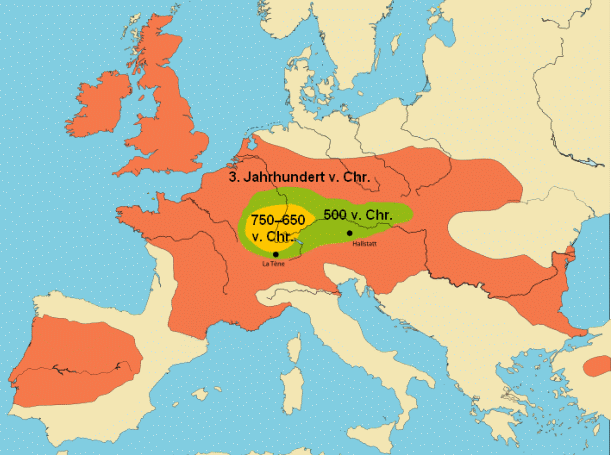
Distribution of Celtic peoples in Europe
The Germanic peoples themselves did not describe themselves using the term Germans and they had no national sense of identity as such. There are some theories on the meaning of the name. They range from “spearmen” to the Latin word “Germen” which means people with the same lineage.
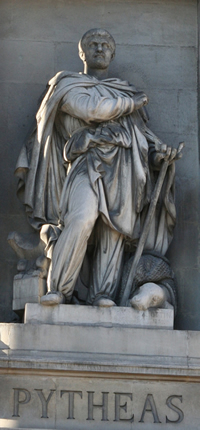
The Greek, Pytheas of Massilia, (today Marseille), one of the great explorers of antiquity, reported in 330 BC, about the countries around the North Sea and the peoples living there. He called all peoples who lived north of the Celts, Teutons: a nation that included the Germans.
The use of the term ‘Germans’ is found, for the first time, by the Greek historian Posidonius of Apamea, in his 30th book written around the year 80 BC. He obviously knew the Germans only as people living close to the Celts2, in the vicinity of the Rhine. He did not include the Cimbri, who lived on the northern edge of the known world, with the Germans.
Even the Greek historian Strabo believed that the Germans and the Gauls were kindred people.
However the term “Teutons” was documented by Gaius Julius Caesar in his book “De bello Gallico” (Commentaries on the Gallic War) in his German digression (Germanenexkurs), 51 BC. He then transferred the concept to all peoples East of the Rhine and designated their land as Germania. Until then, it was assumed that the Celts were north of the Alps in the west, and the Scythians were isolated in the east by the river Tanaïs (Don).
The Roman writer Pomponius Mela, wrote in his De chorographia libri tres (De Chorographis: Libri Tres) that the borders of the German area were the Alps on its southern border, the Rhine on the west, the Vistula and the Sarmatian's territory on the east and the northern sea coast.
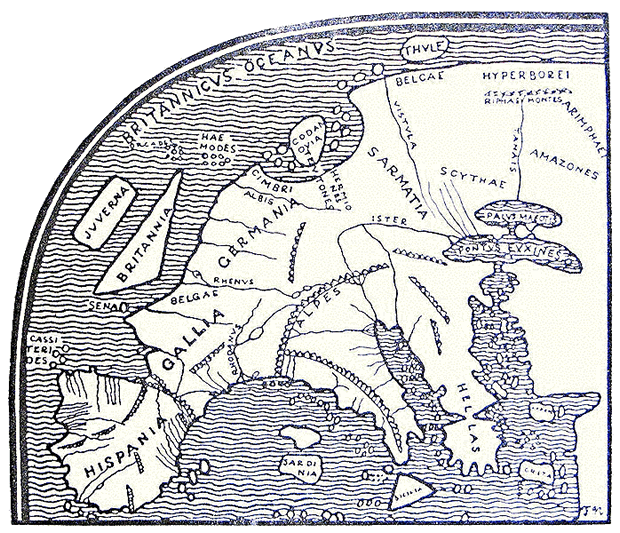
Europe around 44 AD, as described by Pomponius Mela
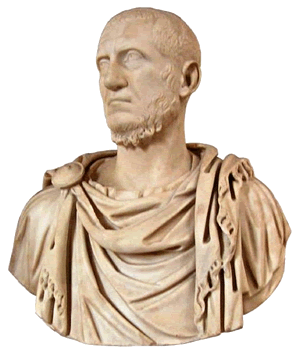
Tacitus
The Roman historian Tacitus, however, had a relatively clear idea of the boundaries of Germania and in 98 he wrote in Chapter 1 of his book, De origine et situ Germanorum (The origin and location of the Germans):
Germania, as a whole, is separated by the Gauls, Rhaetians and Pannonians (Illyrians) by the rivers Rhine and the Danube, from the Sarmatians and Dacians by mutual fear or mountains. The rest flows around the ocean .....
Tacitus himself was uncertain regarding the border in the east, which he suspected to be near the Vistula. Next Tacitus describes the Germanic tribes as native inhabitants and not as immigrants:
Who would want, quite apart from the danger of a hostile and unknown sea, to leave Asia, Africa or Italy and go to Germania with its harsh climate, forbiddingly for cultivation and the sight, - unless one has it as one’s fatherland?
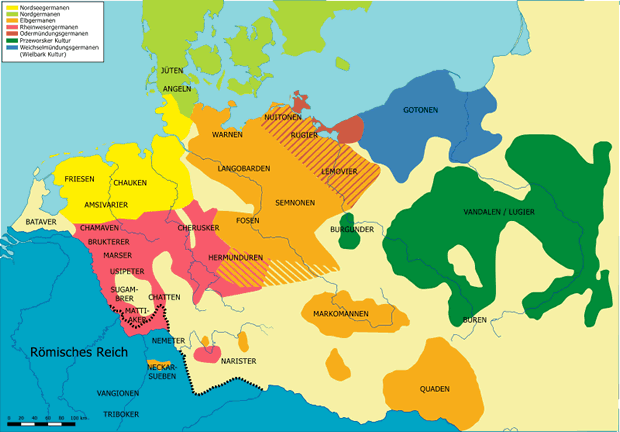
Germanic tribes by 50 AD, as described by Tacitus
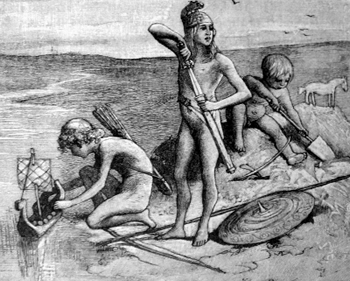
The children of the Norse god Mannus
According to Tacitus, the ancestor and founder of the Germans would be the "mythological figure”, the god Tuisto3, who comes from the Earth, and his son Mannus4 who had three sons: Ing, Irmin and Istvo. They in turn were the progenitors of the three major tribes: Ingaevones, Irminones and Istvaeones. It is said that the Ingaevones lived on the coast, the Irminones in the middle of Germania and the Istvaeones were all the other tribes.
Right after that Tacitus admitted, however, that there are a number of tribes that do not fit into this order, including the Suebi (Suevi) and the Vandals5, which were named by him Vandilii.
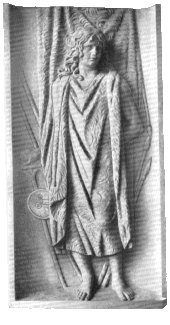
Teuton
Roman Triumphal Relief
in the Vatican Museum in Rome
The actual origin of the Germanic tribes is still not precisely clear or what the name "Germans" means. They probably arrived about 3,500 years ago from the east and spread all over Europe to North Africa.
For the first centuries AD, the Germanic tribes can be differentiated or defined by subdivision into their areas of settlement: the Baltic-Germans in southern Scandinavia; the Vistula Germans, including the Burgundians and the Goths; the Oder-Warta-Germans with the Vandals as the main stem; the North Sea Germans; the Elbe-Germans or Elbe-Suebi which included among others Langobards6, Marcomanni7 and Quadi; the North Sea Germans with Frisians and Saxons; and the Rhine-Weser Germans including Cherusci and Chatti. The important and major tribes like Franks, Alemanni, Saxons and Goths originated only by merger of several small tribes during the third Century AD.
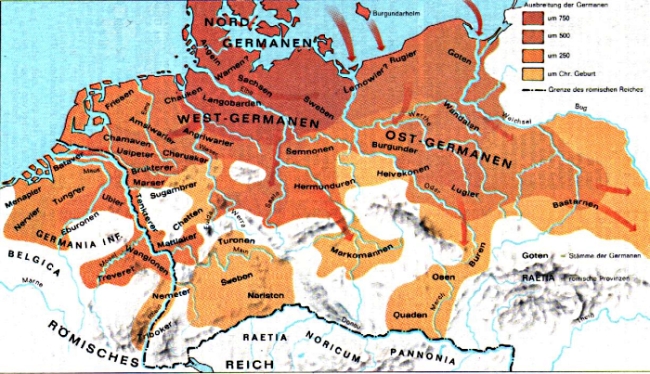
Germanic People
![]()
1 Thanks to S. Winkler for help with the English translation of this page
2 Celts = The core area of early Celtic settlement is in southwestern Central Europe, where they have been detectable at least since 7/6 Century BC. From the year 300 BC, as a result of increasing population density in the original Celtic areas, an increased migration movement occurred of whole detachments of Celtic tribes. Their targets were new settlement areas that they had conquered, only partially, in war. They temporarily occupied Central and Southern Europe from the Iberian Peninsula (Celtiberians), France (Gauls), the British Isles (Wales, Scotland, Ireland), the Northern Alps and foothills, part of the Italian Boot (Etruscans), and down the Danube (Thracians) to the present-day Turkey (Galatians, the same people spoken about in the ninth book of the New Testament). Cities such as Paris, Turin, Budapest and Ankara were established by them.
3 Tuisto, this entity is a ‘double being’ with whom the Germans and other peoples associate the beginning of the world. It combines equally the male and female principle in itself. While it originates from the earth, it brings itself forth from the Mannus.
4 Mannus = In Germanic mythology, Mannus is the forefather, who was derived from the primordial Tuisto. He was the progenitor, the first human, from whom all men descended.
5 Vandals = East Germanic people, whose original settlement area is unknown, however the most important sub-tribes, the Hasdingi and the Silings (Silesia is named after the latter) were first documented in the Oder-Warta-territory. During the Marcomanni wars (166-180) parts of the army of Vandals settled on the eastern slopes of the Carpathians and later in the Tisza basin. In 406/407 the Vandals crossed the Rhine with Suevi and Alans (Caucasian nomads) and advanced in 409 to Spain, where they received land in 411 as Roman federates: Descendents of the Hasdingi and Suevi are in Galicia today, as are descendents of the Silings in Andalusia. Attacked by the Visigoths, about 80,000 Vandals and 80,000 Alans, lead by Geneseric to North Africa in 439, where they founded a kingdom on Roman soil; and conquered in 439. In 455 the Vandals sacked Rome pillaging the town for 14 days. In 533/534 their kingdom was destroyed by the Byzantine general Belisarius.
6 Langobards ("men with long beards" also called Winniler) = Elbe Germanic tribe (part of the Suebi), who settled at the time of the birth of Christ onto the lower Elbe. After hiking and military campaigns ( today's northern and eastern Germany) they occupied areas north of Noricum by 490. Langobards were first mentioned in 488 in the Land of Rugii (Lower Austria). In 508/509 they defeated the Heruli and took over their kingdom on the Morava in today's south of Slovakia. In the 6th Century they extended their settlements to Pannonia to the Sava, destroyed the kingdom of the Gepids in 567 in today's Transylvania and in 568, under King Alboin, they broke into the then Byzantine Italy. The Langobards kingdom with its capital at Pavia encompassed northern Italy and parts of central and southern Italy. Charlemagne, king of the Frankish Empire, conquered Pavia in 774 and crowned himself king of the Langobards. In 951 the territory of the Langobards was connected by Otto I, King of East Frank Empire (Ostfrankenreich), with the Holy Roman Empire of the German Nation. The Duchies of Benevento, Capua and Salerno in the south initially remained independent, until the 11th Century when they came under Norman rule.
7 Marcomanni (in German: Markomannen, the plural of Markomann; it is a composed substantive of Mark (antique word for border area) and Mann (man); the 'o' between the two words can be considered like a glue for a easier pronunciation; so the significant is: men who lives in the border area) were a large Germanic group of the Suevi tribe, probably expelled from the Elbe at the beginning of the 1st century BC. They then settled on the Main River, in the current Franconia and displaced the indigenous Celts.
During Caesar's time, they were in the north-eastern half of the Kingdom of Bavaria. They had been defeated by the Romans in 9 BC and together with the Quadi under King Maroboduus they moved to Bohemia, to the land of the Boii (Celtic tribe) which penetrated from Gaul around 400 BC to an area in Nothern Italy (capital Bononia, today Bologna) or in Bohemia (Boiohaemum named after him), situated in the north of the Danube, where Maroboduus, in alliance with other Germanic tribes established a great Germanic Empire, which was perceived by the Roman Emperor Augustus as a potential threat to Rome. In 19 AD, the Marcomanni, came under Roman influence and were a Roman client state for 30 years. The pressure of other Germanic tribes, social and economic changes, and the weakness of the defense of the Roman Empire led to the Marcomannic wars, which lasted, with interruptions from 166 to 180 AD.
In 433 the Marcomanni, living in Pannonia, came under the rule of the Huns. In the 6th century, they immigrated to Bavaria and their name is gradually lost. From then on, it appeared under the name of Bavaria, a name that they had already brought from their Bohemian homeland, where they were called 'Vaiwarier', i.e. residents of Baiheim in Bohemia.
